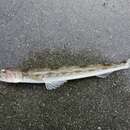fr
noms dans le fil d’Ariane


The California lizardfish (Synodus lucioceps) is a species of lizardfish primarily inhabiting the Californian coast.[2] It has a long, brown body, which offers it camouflage in its habitat, the sandy bottom of the ocean. From its hiding spot on the bottom it ambushes small fish and squid. California lizardfish are oviparous and are believed to spawn in the summer months.
The California lizardfish derives its name from its elongated cylindrical body and lizard-like head and mouth. The body is uniformly brown on its back, with its sides fading to tan and a white belly.[3] It has a dorsal fin at its midback, no spinous fin rays, a small adipose fin, yellowish pelvic fins ahead of its dorsal fin with about eight or nine rays each, and a forked caudal fin.[4] The longest fish recorded was 25.17 inches (63.9 cm) long, and may weigh up to 4 pounds (1.8 kg).[5]
Because of its long body and sharp teeth, the California lizardfish is occasionally mistaken for the barracuda. The barracuda, however, is silvery rather than brown and has two similar-sized dorsal fins with a wide space between them, whereas the lizardfish only has a single dorsal fin with a tiny fleshy fin behind it.[5]
The California lizardfish occurs from Guaymas, Mexico to San Francisco, California. Some specimens have even been found as far north as British Columbia, Canada and as far south as the Galapagos Islands. Although it is most commonly found on sandy bottoms in shallow water ranging from 5 to 150 feet deep, specimens have been found at depths up to 750 feet.[6]
The California lizardfish is not sought by most anglers because its flesh has a strong taste resembling iodine, but can uncommonly be taken in fairly large numbers by anglers fishing for halibut and other shallow water bottom-dwelling fish. They will take most baited hooks.[7]
The California lizardfish spends most of its time camouflaged at the sandy bottom, buried or unburied, with its body propped up by its front ventral fins at a slight angle.[8] When prey in the form of small fish or squid swims past, the fish will dart upward to grab it, swallowing the prey whole.[9] This species is believed to spawn during the summer months, when adult fish have been observed to congregate on sandy patches. Young lizardfish are less than 3 inches (7.6 cm) long, nearly transparent, and scaleless, with a row of large black spots under the skin of the belly.[4] They may live for about nine years, as the otoliths of a specimen taken off the Galapagos Islands indicates.[7] The California lizardfish is also host to a parasitic tapeworm, Anantrum histocephalum.[10]
The California lizardfish (Synodus lucioceps) is a species of lizardfish primarily inhabiting the Californian coast. It has a long, brown body, which offers it camouflage in its habitat, the sandy bottom of the ocean. From its hiding spot on the bottom it ambushes small fish and squid. California lizardfish are oviparous and are believed to spawn in the summer months.
Synodus lucioceps Synodus generoko animalia da. Arrainen barruko Synodontidae familian sailkatzen da.
Synodus lucioceps Synodus generoko animalia da. Arrainen barruko Synodontidae familian sailkatzen da.
Synodus lucioceps is een straalvinnige vissensoort uit de familie van hagedisvissen (Synodontidae).[2] De wetenschappelijke naam van de soort is voor het eerst geldig gepubliceerd in 1855 door Ayres.
De soort staat op de Rode Lijst van de IUCN als niet bedreigd, beoordelingsjaar 2007.[1]
Bronnen, noten en/of referenties尖頭狗母魚,為輻鰭魚綱仙女魚目合齒魚亞目合齒魚科的其中一種,分布於東太平洋區,從美國加州舊金山至墨西哥Guayamas海域,棲息深度1-229公尺,體長可達64公分,為底棲性魚類,生活在沙石底質、礁石區海域,屬肉食性,以魚類為食。
尖頭狗母魚,為輻鰭魚綱仙女魚目合齒魚亞目合齒魚科的其中一種,分布於東太平洋區,從美國加州舊金山至墨西哥Guayamas海域,棲息深度1-229公尺,體長可達64公分,為底棲性魚類,生活在沙石底質、礁石區海域,屬肉食性,以魚類為食。